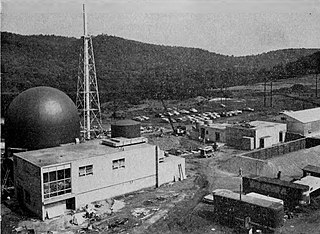
A nuclear reactor is a device used to initiate and control a fission nuclear chain reaction. Nuclear reactors are used at nuclear power plants for electricity generation and in nuclear marine propulsion. When a fissile nucleus like uranium-235 or plutonium-239 absorbs a neutron, it splits into lighter nuclei, releasing energy, gamma radiation, and free neutrons, which can induce further fission in a self-sustaining chain reaction. The process is carefully controlled using control rods and neutron moderators to regulate the number of neutrons that continue the reaction, ensuring the reactor operates safely, although inherent control by means of delayed neutrons also plays an important role in reactor output control. The efficiency of nuclear fuel is much higher than fossil fuels; the 5% enriched uranium used in the newest reactors has an energy density 120,000 times higher than coal.

The Nyongbyon Nuclear Scientific Research Center (녕변원자력연구소) is North Korea's major nuclear facility, operating its first nuclear reactors. It is located in Nyongbyon County in North Pyongan Province, about 100 km north of Pyongyang. The center produced the fissile material for North Korea's six nuclear weapon tests from 2006 to 2017, and since 2009 is developing indigenous light water reactor nuclear power station technology.
The Army Nuclear Power Program (ANPP) was a program of the United States Army to develop small pressurized water and boiling water nuclear power reactors to generate electrical and space-heating energy primarily at remote, relatively inaccessible sites. The ANPP had several accomplishments, but ultimately it was considered to be "a solution in search of a problem." The U.S. Army Engineer Reactors Group managed this program and it was headquartered at Fort Belvoir, Virginia. The program began in 1954 as the Army Reactors Branch and had effectively terminated by about 1977, with the last class of NPP operators graduating in 1977. Work continued for some time thereafter either for decommissioning of the plants or placing them into SAFSTOR. The current development of small modular reactors has led to a renewed interest in military applications.

The Bhabha Atomic Research Centre (BARC) is India's premier nuclear research facility, headquartered in Trombay, Mumbai, Maharashtra, India. It was founded by Homi Jehangir Bhabha as the Atomic Energy Establishment, Trombay (AEET) in January 1954 as a multidisciplinary research program essential for India's nuclear program. It operates under the Department of Atomic Energy (DAE), which is directly overseen by the Prime Minister of India.

Aqueous homogeneous reactors (AHR) is a two (2) chamber reactor consisting of an interior reactor chamber and an outside cooling and moderating jacket chamber. They are a type of nuclear reactor in which soluble nuclear salts are dissolved in water. The fuel is mixed with heavy or light water which partially moderates and cools the reactor. The outside layer of the reactor has more water which also partially cools and acts as a moderator. The water can be either heavy water or ordinary (light) water, which slows neutrons and helps facilitate a stable reaction, both of which need to be very pure.

The Saxton Nuclear Experiment Station, also known as the Saxton Nuclear Generating Station or Saxton Nuclear Experimental Corporation Facility, was a small nuclear power plant located in Bedford County, near Saxton, Pennsylvania.

The National Atomic Energy Commission is the Argentine government agency in charge of nuclear energy research and development.
The Chashma Nuclear Power Plant is a large commercial nuclear power plant located at Chashma in Mianwali, Punjab, Pakistan.

Winfrith Atomic Energy Establishment, or AEE Winfrith, was a United Kingdom Atomic Energy Authority site near Winfrith Newburgh in Dorset. It covered an area on Winfrith Heath to the west of the village of Wool between the A352 road and the South West Main Line.
In Pakistan, nuclear power is provided by six commercial nuclear power plants with a net capacity of 3,262 megawatts (3.262 GW) from pressurized water reactors. In 2020, Pakistan's nuclear power plants produced a total of 133 terawatt-hours of electricity, which accounted for roughly 10% of the nation's total electric energy generation.

Carolinas–Virginia Tube Reactor (CVTR), also known as Parr Nuclear Station, was an experimental pressurized tube heavy water nuclear power reactor at Parr, South Carolina in Fairfield County. It was built and operated by the Carolinas Virginia Nuclear Power Associates. CVTR was a small test reactor, capable of generating 17 megawatts of electricity. It was officially commissioned in December 1963 and left service in January 1967.
The Pennsylvania State University (PSU) Radiation Science & Engineering Center (RSEC) houses the Breazeale Nuclear Reactor (BNR). This reactor is the oldest operating in the nation and has undergone numerous power upgrades, renovations, and other changes. The reactor serves the research purposes of the Penn State Department of Mechanical and Nuclear Engineering as well as researchers from industry and other universities. Its total licensed thermal output is 1.1 MW, however the reactor is procedurally limited to 1.0 MW (for 100% operation).

The Maria reactor is Poland's second nuclear research reactor, commissioned in December 1974, and the only one still in use. The first was the Ewa reactor (EWA), which was commissioned in June 1958 and dismantled by 2002. It is located at Narodowe Centrum Badań Jądrowych - "NCBJ" at Świerk-Otwock, near Warsaw and named in honor of Maria Skłodowska-Curie. It is the only reactor of Polish design.
Nuclear power is the fifth-largest source of electricity in India after coal, hydro, solar and wind. As of November 2023, India has 23 nuclear reactors in operation in 8 nuclear power plants, with a total installed capacity of 8,180 MW. Nuclear power produced a total of 48 TWh in 2023, contributing around 3% of total power generation in India. 11 more reactors are under construction with a combined generation capacity of 8,700 MW.

Iran's nuclear program is made up of a number of nuclear facilities, including nuclear reactors and various nuclear fuel cycle facilities.

IR-40 also known as Arak Nuclear Complex is an Iranian 40 megawatt (thermal) heavy water reactor near Arak, adjacent to the 1990s era Arak Heavy Water Production Plant. Civil works for the construction began in October 2004. It was initially planned that the reactor would begin nuclear operations in 2014.

The Pakistan Atomic Research Reactor or (PARR) are two nuclear research reactors and two other experimental neutron sources located in the PINSTECH Laboratory, Nilore, Islamabad, Pakistan.

The IPHWR-700 is an Indian pressurized heavy-water reactor designed by the NPCIL. It is a Generation III reactor developed from earlier CANDU based 220 MW and 540 MW designs. It can generate 700 MW of electricity. Currently there are two units operational, 6 units under construction and 8 more units planned, at a cost of ₹1.05 lakh crore (US$13 billion).
The Anna reactor was a Polish research nuclear reactor of graphite-water design. Construction began in 1961 in a dedicated building in the Institute for Nuclear Research in Otwock near Warsaw. The Anna reactor was commissioned on June 12, 1963, thus becoming the second and eventually the third most powerful nuclear reactor in Poland.













